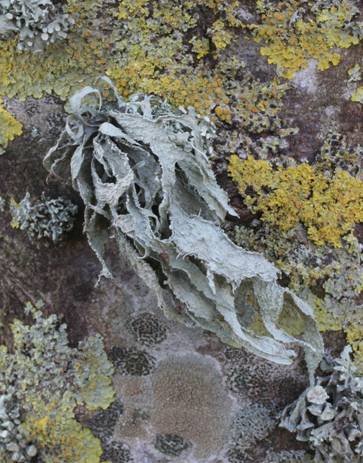Lichens
This section is based upon a survey and report commissioned by Natural England and undertaken by Barbara Benfield in March 2007. Many thanks to both for allowing the information to be used on the website.
|
|
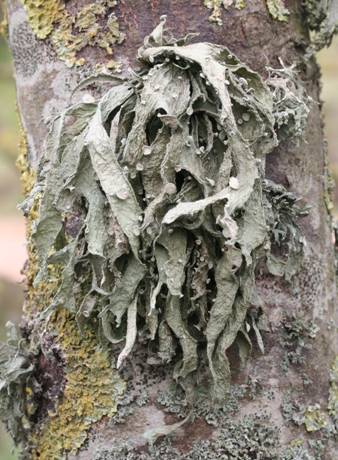 |
This lichen has a conservation category of international responsibility, and can be found growing on Sycamores along the dune ridge.
Summary
Dawlish Warren was visited to assess the lichen value of scrub and trees in the dune system. Ground (terricolous) habitats were also investigated in order to compare their importance with that found on the scrub.
Previous lichen records.
The first lichen recorded known from Dawlish Warren was made by Mr. Brodie in 1805 when it was noted that Usnea articulata 'was upon broken sand banks in the Warren opposite Exmouth’. This sample was described as being thick as a little finger which impressed Mr. Brodie and, due to an overall deterioration of lichen size since the 19th century, would be even more impressive today. There is a later record of Usnea articultata on heather at Exmouth Warren mentioned by Parfitt (1871). This sample is in the Natural History Museum and was re-determined as Usnea subfloridana. No U. articulata has been noted there since.
Only four lichen species were recorded at Dawlish Warren between 1957 and 1974. All are terricolous species, none was from scrub.
A literature search has shown that a more comprehensive list was made during the 1980s when 22 corticolous (tree) lichens were recorded, Lichens on other substrates were included. Cladonia foliacea, a large lobed yellow-green species which grows on thin basic soil, has not been recorded at the Warren since.
Survey Method
The Warren was visited in March 2007 after an exceptionally long wet period. Water levels were high and some of the terricolous (ground) lichens were inundated. The outer dunes, inner dunes, north of the main track and spit were listed separately. Lichens on the soil and the scrub were recorded. Although some lichens growing on stones were recorded they have not been included here.
Lichen names used are from Coppins (2002). The conservation status of lichens follows Woods & Coppins (2003).
Results
A total of 86 lichens was recorded, 62 species from soil, scrub and trees.
1. The Outer Warren (Cuckoo’s Nest, Dune Ridge & Wryneck Plain) The area south of the main track, from the car park to the end of the golf course.
The remaining shrubs in this area are covered with an eye catching assemblage of common pioneer lichen species found where nutrient levels are high. The branches of elder especially, are golden with the common species, Xanthoria parietina. Scattered willows and sycamores at the western end are the hosts for a more diverse flora.
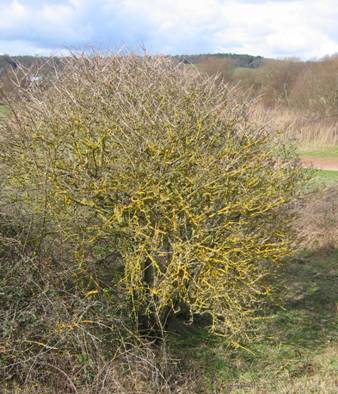
Xanthoria parietina covering branches of well-lit elder with yellow. This is a common, eye catching feature on scrub at the Warren.
The most interesting community of lichens in this section is terricolous. The acidic nature of the sand was revealed by a selection of lichens which are normally found growing on trees (corticolous) which do not have a high bark pH. Evernia prunastri, Flavoparmelia caperata, Hypogymnia physodes and Parmelia saxatilis are all well developed. The exception which is never found on trees, Diploscistes muscorum is initially a parasite on Cladonia species before developing a self contained thallus of its own. The most extensive area of soil lichen cover is along the Wryneck Plain, here Cladonia furcata and Cladonia rangiformis form large mats but the species diversity is small.
It is interesting to note that although Hypogymnia physodes is well developed on the sand, the less common Hypogymnia tubulosa was seen on branches of two sycamores at the western end. The recently increasing lichen, Flavoparmelia soredians, was also found on the same sycamores. The lichen flora in this area benefits from the presence of some sycamores, it is therefore disappointing the survey was only undertaken after the largest and most lichen rich Sycamores were removed.
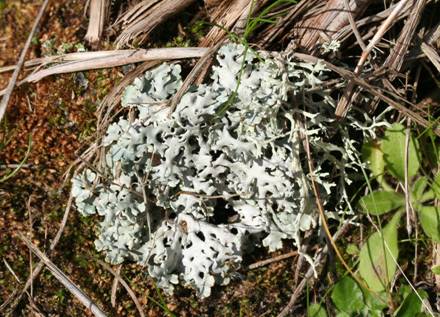
Hypogymnia physodes on moss on sand of the Outer Warren. This species usually grows on acidic bark and rock and is an indication of the non calcareous nature of the sand. Once a common lichen, it has declined since the increase of nutrient levels in western Europe.
The sand community appears healthy and thriving, whereas the same species on the trees are often discoloured and disintegrating. This seems to indicate that in the areas where the lichens are present on the sand, the soils are unaffected by any nutrient enrichment or higher pH which may be affecting exposed branches.
2. Area to the north of the main track. (Entrance Bushes, Greenland Lake, Main Pond, Back Path and Dead Dolphin Wood)
The willows at the western end of the reserve have a high percentage and healthy cover of the Parmelietum revolutae community due to mutual shelter of scrub and the high water table. Nothing unusual was found but the quantity of lichen biomass may be a food source for invertebrates which rely on lichens.
Beside the Visitor Centre large patches of Cladonia furcata, C. rangiformis and Peltigera membranacea are dominating parts of a grassy area. Some of the lichens were under water in March. The Cladonias did not appear to be affected by submersion at that stage but Peltigera membranacea had become bleached.
The lichen flora on the trees round the lake is not unusual but Parmotrema perlata and Phaeophyscia distorta are well developed in places. Both are common species but P. distorta less so. It appears to have a narrow band of tolerance of moderately nutrient enriched conditions.
Between Greenland Lake and the golf course the ‘reindeer lichens’ Cladonia furcata and C. rangiformis are present in great quantities especially on the flatter area near the lake margin.
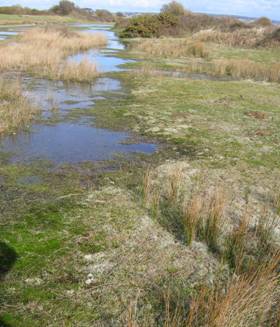
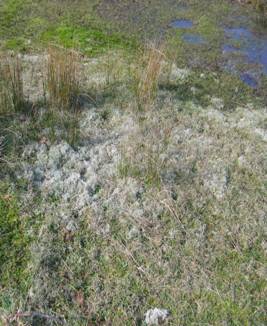
A prolific flora of Cladonia furcata and C. rangiformis surrounding Greenland Lake. Both can grow relatively fast through the vegetation.
3. Warren Point & Neck and the fore dunes.
Sycamores which are sheltered from the sea by the dunes or by surrounding scrub provided a habitat for a prolific growth of the Ramalina community. Although there are few trees left in this area these multi stemmed sycamores are the only significant corticolous substrate on Warren Point. They have a high percentage cover of lichens requiring well lit branches. Those present include Ramalina canariensis, Ramalina farinacea, Ramalina fastigiata, Ramalina fraxinea and Ramalina lacera. R. lacera is locally scarce and R. fraxinea, which is up to 7cm long here, is a declining species for which the UK has an International Responsibility.
Another declining, mainly western species, Melanelia exasperata, was also found on these sycamores.
3a. The dunes on the seaward side.
A significant terriclous community has colonised patches of sand and dead vegetation on the inner, south facing slope of the dune facing the sea. Of particular note is Peltigera didactyla. It has a scattered distribution in Devon but is never common. In the same area the assemblage similar to that found on the ground near the Visitor Centre has developed. As a sand community is vulnerable it is listed in full: Cladonia chlorophaea, Cladonia coniocrea, Cladonia fimbriata, Cladonia rangiformis, Collema tuniforme, Evernia prunastri, Flavoparmelia caperata, Hypogymnia physodes, Hypotrachyna revoluta, Parmelia sulcata, Parmotrema perlata, Peltigera canina and Physcia tenella. More importantly, the nationally scarce Peltigera neckeri is growing on moss on damp, stable sand near the end of Warren Point.
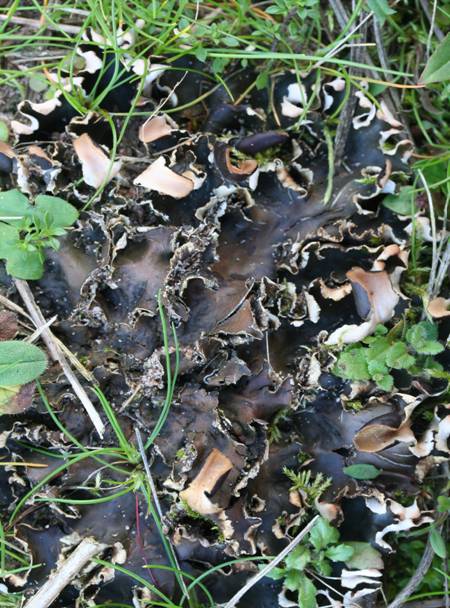
Peltigera neckeri (nationally scarce) on sand at Warren Point.
Lichens of special interest found at Dawlish Warren
Peltigera didactyla - a locally scarce species occasionally found on wall tops, bonfire sites and dunes.
Peltigera neckeri - is a nationally scarce lichen with a very scattered distribution. This is the 4th county record.
Ramalina fraxinea - is declining throughout Europe and has therefore been designated with the status of ‘international responsibility’ (IR). It grows on well-ventilated parts of basic barked trees in open situations.
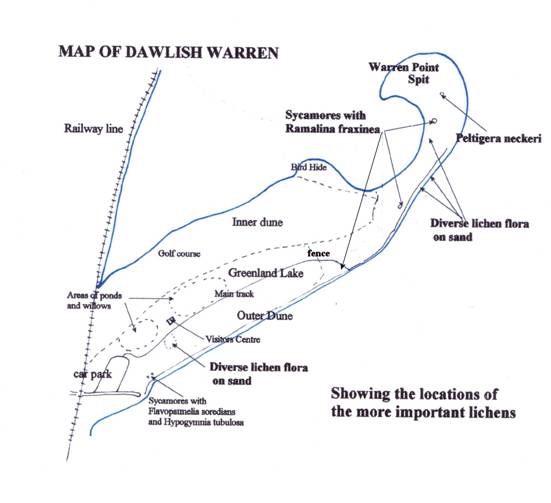
Communities
The twig lichen flora is primarily one which thrives in well lit, nutrient enriched sites and is dominated by the Xanthoria-Physcia community. Maritime habitats are thought to be the natural conditions for this group of lichens which have become abundant in nutrient enriched agricultural inland sites.
The dominant flora on the older trees belongs to the Parmelietum revolutae. Of the 27 lichens listed as members of this community, 18 are present at Dawlish Warren. It is best developed on well lit trees in open situations or on branches in woodland canopies in southern and western Britain. Pollution impoverishes it to varying degrees (James, Hawksworth and Rose 1977)
The Ramalinetum fastigiatae is a widespread community characterized by the dominance of Ramailina species. It is best developed in maritime situations. All six of the members of this association were found on the remaining sycamores at Dawlish Warren.
A separate community was found on the sand. It is a mixture of corticolous and terriclolous species. Most lichens found in such situations require open habitats with bare but more or less stable soil. Exceptions are Cladonia furcata and C. rangiformis whose erect and relatively fast growing thalli are able to compete among higher plants. Apart from Peltigera neckeri none of the individuals are scarce but the unusual occurrence of lichens growing on the ground, many of which are usually found on trees, makes this a special part of the diversity found on the Warren.
Species List
|
Lichen |
Outer Warren |
Warren Point |
Inner Warren |
substrate |
Status |
abundance |
|
Amandinea punctata |
|
|
+ |
corticolous |
|
Rare |
|
Anisomeridium biforme |
|
+ |
+ |
corticolous |
|
Occasional |
|
A. polypori |
+ |
|
+ |
corticolous |
|
Frequent |
|
Arthonia radiata |
+ |
+ |
+ |
corticolous |
|
Frequent |
|
Baeomyces rufus |
+ |
|
|
terricolous |
|
Occasional |
|
Candelariella reflexa |
|
+ |
+ |
corticolous |
|
Frequent |
|
Cladonia chlorophaea |
|
+ |
|
corticolous |
|
Occasional |
|
C. coniocrea |
+ |
|
|
cort/ter |
|
Occasional |
|
C. fimbriata |
+ |
|
+ |
terricolous |
|
Frequent |
|
C. furcata |
+ |
+ |
+ |
terricolous |
|
Abundant |
|
C. humilis |
|
+ |
|
terricolous |
|
Rare |
|
C. polydactyla |
+ |
|
|
terricolous |
|
Occasional |
|
C. pyxidata |
|
+ |
|
terricolous |
|
Frequent |
|
C. rangiformis |
+ |
+ |
+ |
terricolous |
|
Abundant |
|
C. squamosa |
|
|
+ |
corticolous |
|
Occasional |
|
Cliostomum griffithii |
+ |
+ |
+ |
corticolous |
|
Common |
|
Collema tuniforme |
|
+ |
|
terricolous |
|
Rare |
|
Diploicia canescens |
|
+ |
+ |
corticolous |
|
Frequent |
|
Evernia prunastri |
+ |
+ |
+ |
corticolous |
|
Abundant |
|
Flavoparmelia caperata |
+ |
+ |
+ |
corticolous |
|
Abundant |
|
F. soredians |
|
+ |
|
corticolous |
|
Rare |
|
Fuscidea lightfootii |
|
+ |
+ |
corticolous |
|
Frequent |
|
Hyperphyscia adglutinata |
|
|
+ |
corticolous |
NIW |
Occasional |
|
Hypogymnia physodes |
+ |
|
|
cort/ter |
AIW |
Occasional |
|
H. tubulosa |
|
|
+ |
corticolous |
AIW |
Rare |
|
Hypotrachyna revoluta |
|
|
+ |
corticolous |
|
Common |
|
Lecanora carpinea |
+ |
|
|
corticolous |
|
Rare |
|
L. chlarotera |
|
+ |
+ |
corticolous |
|
Common |
|
L. compallens |
|
+ |
|
corticolous |
|
Rare |
|
L. confusa |
+ |
+ |
+ |
corticolous |
|
Common |
|
L. conizaeoides |
+ |
|
|
corticolous |
|
Rare |
|
L. dispersa |
+ |
+ |
|
corticolous |
|
Frequent |
|
L. persimilis |
|
+ |
|
corticolous |
|
Rare |
|
L. symicta |
+ |
|
|
corticolous |
|
Rare |
|
Lecidella elaeochroma |
+ |
+ |
+ |
corticolous |
|
Abundant |
|
Melanelia exasperata |
+ |
|
|
corticolous |
|
Occasional |
|
M. fuliginosa glabratula |
|
|
+ |
corticolous |
|
Rare |
|
M. subaurifera |
+ |
+ |
+ |
corticolous |
|
Common |
|
Parmelia saxatilis |
+ |
|
|
cor/ter |
|
Rare |
|
P. sulcata |
+ |
+ |
+ |
corticolous |
|
Abundant |
|
Parmotrema perlata |
+ |
+ |
+ |
corticolous |
|
Abundant |
|
Peltigera canina |
+ |
+ |
|
terricolous |
|
Frequent |
|
P. didactyla |
|
+ |
|
terricolous |
LS |
Frequent |
|
P. hymenia |
|
+ |
|
terricolous |
|
Common |
|
P. membranacea |
+ |
+ |
|
corticolous |
|
Common |
|
P. neckeri |
|
+ |
|
terricolous |
NS |
Rare |
|
Pertusaria hymenia |
|
|
+ |
corticolous |
|
Occasional |
|
Phaeophyscia orbicularis |
+ |
+ |
+ |
corticolous |
|
Frequent |
|
Physcia adscendens |
+ |
+ |
+ |
corticolous |
NIW |
Abundant |
|
P. aipolia |
+ |
+ |
+ |
corticolous |
|
Abundant |
|
P. tenella |
+ |
+ |
+ |
corticolous |
NIW |
Abundant |
|
Physconia distorta |
|
+ |
+ |
corticolous |
|
Frequent |
|
P. grisea |
|
+ |
|
corticolous |
|
Occasional |
|
Placynthiella icmalea |
+ |
|
|
corticolous |
|
Rare |
|
Punctelia subrudecta |
+ |
|
+ |
corticolous |
|
Occasional |
|
Ramalina canariensis |
+ |
+ |
+ |
corticolous |
|
Common |
|
R. farinacea |
+ |
+ |
+ |
corticolous |
|
Abundant |
|
R. fastigiata |
+ |
+ |
+ |
corticolous |
|
Abundant |
|
R. fraxinea |
+ |
+ |
|
corticolous |
IR |
Rare |
|
Rinodina sophodes |
+ |
+ |
+ |
corticolous |
|
Frequent |
|
Usnea cornuta |
|
|
+ |
corticolous |
|
Occasional |
|
Xanthoria parietina |
+ |
+ |
+ |
corticolous |
NIW |
Abundant |
|
X. polycarpa |
+ |
+ |
|
corticolous |
NIW |
Occasional |
|
Total 51 |
38 |
41 |
37 |
|
|
|
AIW & NIW indicate acidophytes and nitrophytes.
IR = Lichens which are rare in the rest of Europe and for which Britain has international responsibility.
NS = Nationally Scarce
LS = Locally scarce
Corticolous= lichens growing on trees or shrubs
Terricolous = lichens growing on the ground
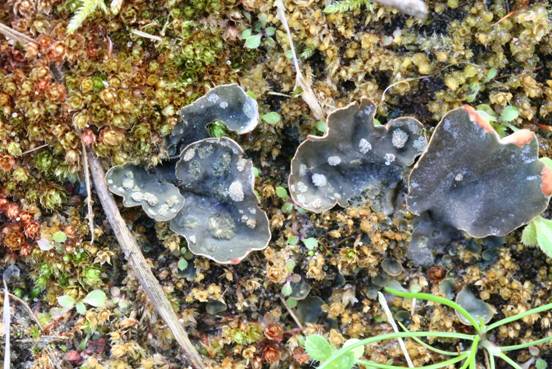
Peltigera didactyla (locally scarce) is frequent along the south facing dune of the Outer Warren.
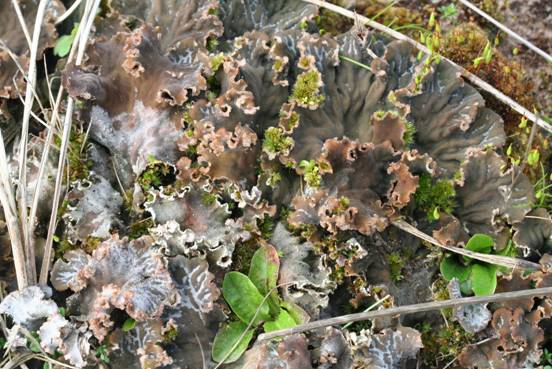
Peltigera canina in the same place.
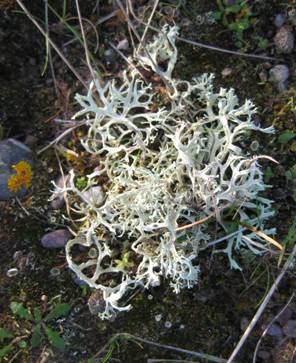
Evernia prunastri growing on sand near the Visitor Centre, an unusual habitat for this corticolous lichen
References
Benfield, B. 2001. The Lichen Flora of Devon. Newton Abbot
Benfield, B. 2007. Lichen Survey of Scrub at Braunton Burrows. Report for Natural England.
Church,J.M. et al. 1996. Red Data Book of Britain and Ireland: Lichens Vol 1: Britain. JNCC
Coppins, B.J. 2002. Checklist of Lichens of Great Britain and Ireland. British Lichen Society
Fletcher, A. 2001. Lichen Habitat Management. BLS and CCW
Hodgetts, N.G. 1992.Guidelines for selection of Biological SSSIs. Non Vascular Plants. Peterborough.
James, P.W., Hawksworth, D. L. & Rose, F. 1977 Lichen Communities in the British Isles in Lichen Ecology ed. Seaward, M.R.D. Academic Press
Rylands, K. Compiler of the Dawlish Warren web site.
Seaward, M.R.D. Maps of British Lichens BLS mapping scheme. Bradford University
van Herk, K. (1999) Mapping of Ammonia Pollution with Epiphytic Lichens in the Netherlands. Lichenologist 31.
Wallace, T. (1953) The Plant Ecology of Dawlish Warren. Report and Transactions of the Devonshire Association Vol 85
Woods, R. & Coppins B.J. 2003. A Conservation Evaluation of British Lichens. British Lichen Society
Other species found at Dawlish Warren (primarily on rock and mortar)
Caloplaca dalmatica
C. flavescens
C. flavocitrina
C. holocarpa
C. thalincola
Clauzadea monticola
Collema auriforme
C. crispum
Diplotomma alboatrum
Lecania erysibe
Lecanora albescens
L. campestris
Lecidella stigmatea
Leproloma vouauxii
Physcia caesia
Porpidea cinerioatra
Rhizocarpon reductum
Rinodina genarii
Sarcogyne regularis
Verrucaria hotchstetteri
V. viridula
